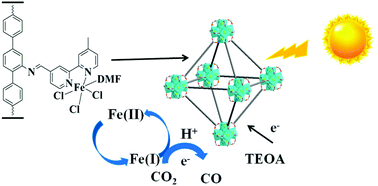Iron(iii)-bipyridine incorporated metal–organic frameworks for photocatalytic reduction of CO2 with improved performance†
Abstract
Metal–organic frameworks (MOFs) represent an emerging class of platforms to assemble single site photocatalysts for artificial photosynthesis. In this work, we report a new CO2 reduction photocatalyst (UiO-68-Fe-bpy) based on a robust Zr(IV)-MOF platform with incorporated Fe(bpy)Cl3 (bpy refers to the 4′-methyl-[2,2′-bipyridine] moiety) via amine–aldehyde condensation. We show that this hybrid catalyst can reduce CO2 to form CO under visible light illumination with excellent selectivity and enhanced activity with respect to its parent MOF and corresponding homogeneous counterpart. Using steady state and transient absorption (TA) spectroscopy, we show that the enhanced photocatalytic activity of UiO-68-Fe-bpy is attributed to the elongated excited state lifetime of Fe(bpy)Cl3 after being incorporated to the UiO-68-NH2 platform. This work demonstrates the great potential of MOFs as a next generation platform for solar fuel conversion.



 Please wait while we load your content...
Please wait while we load your content...